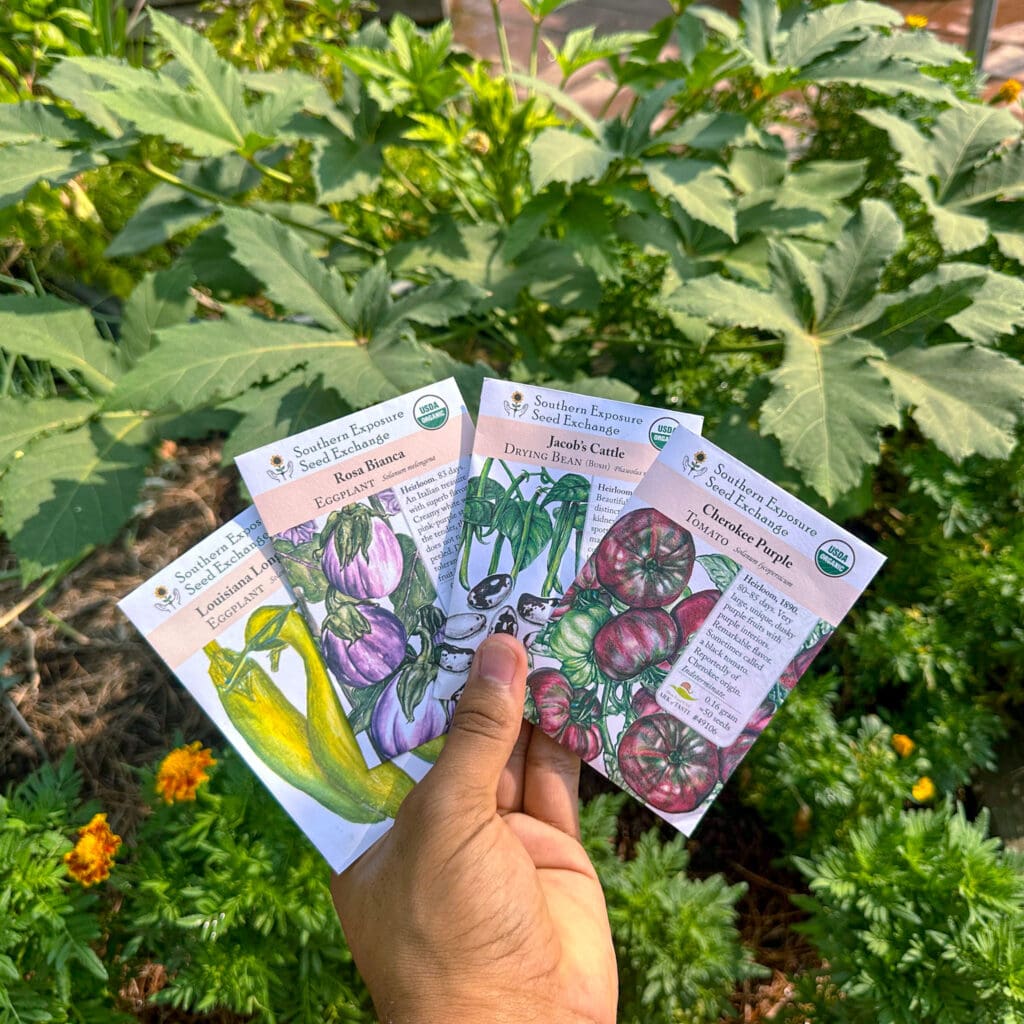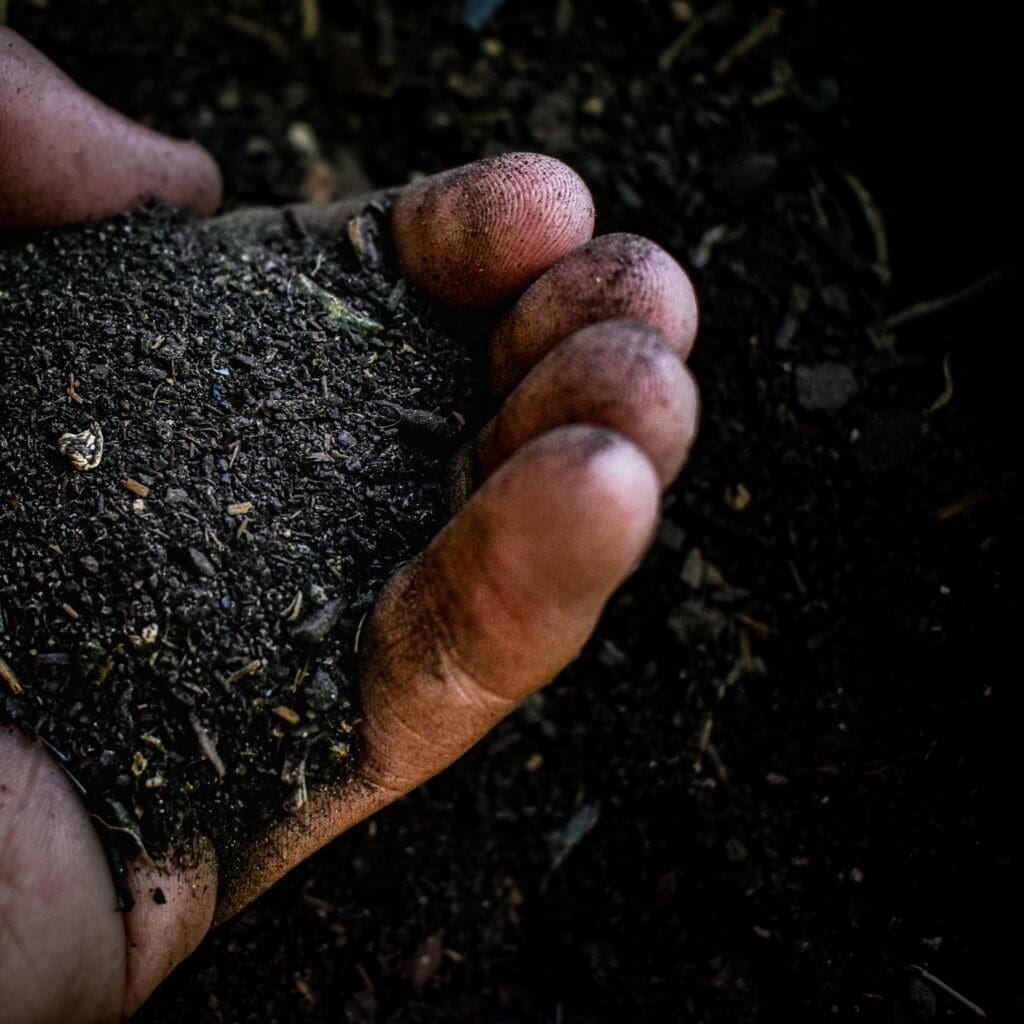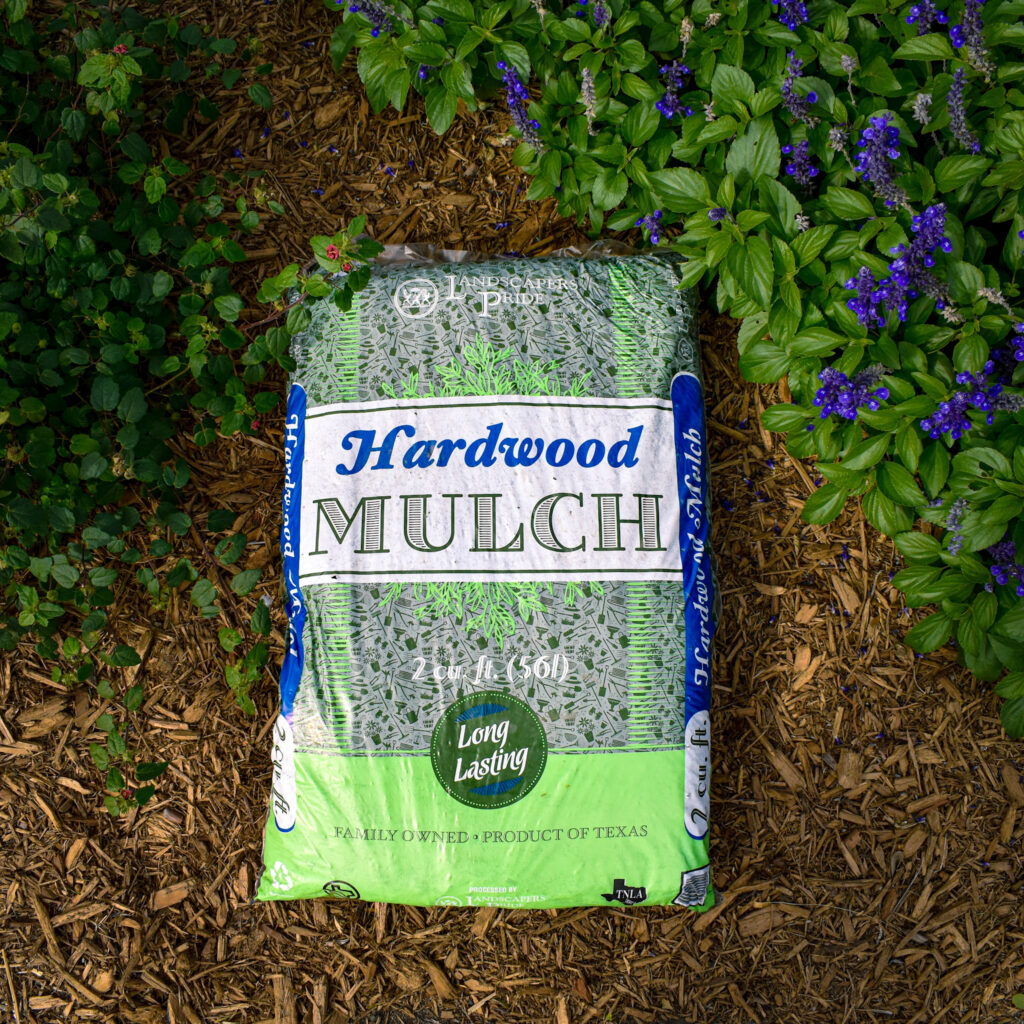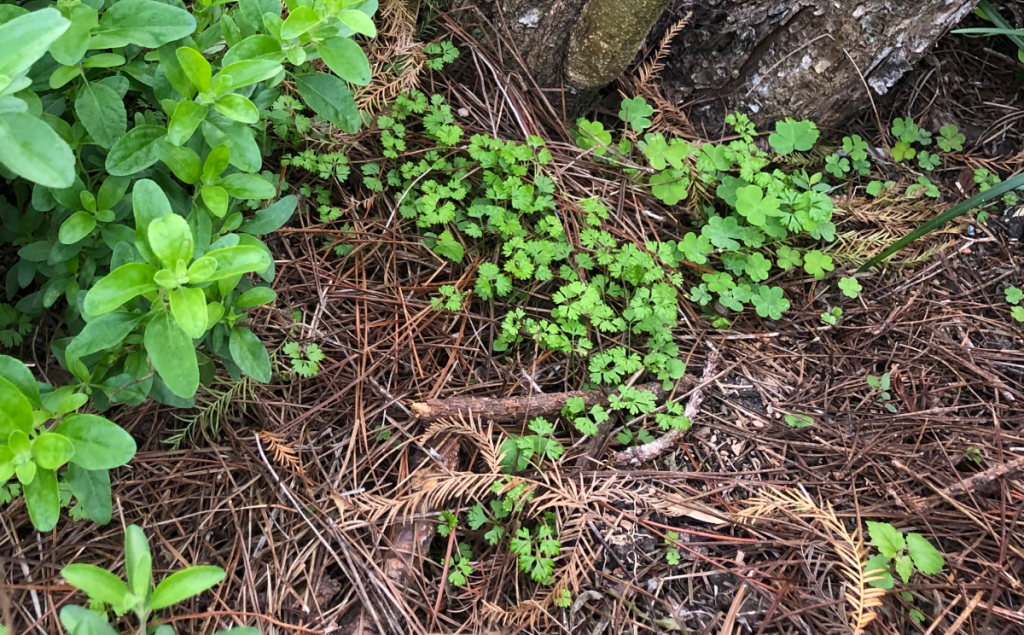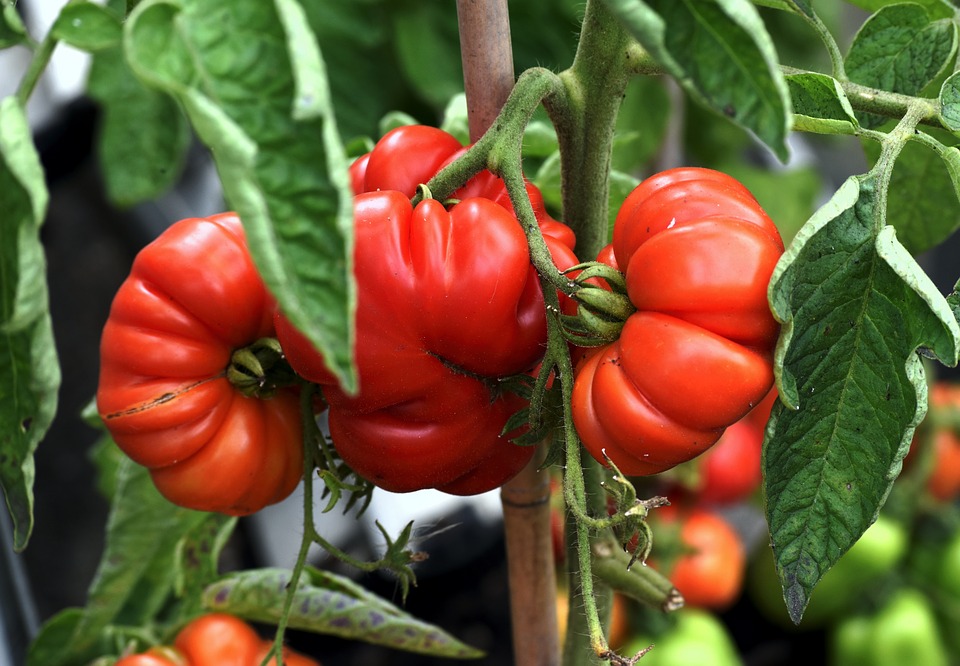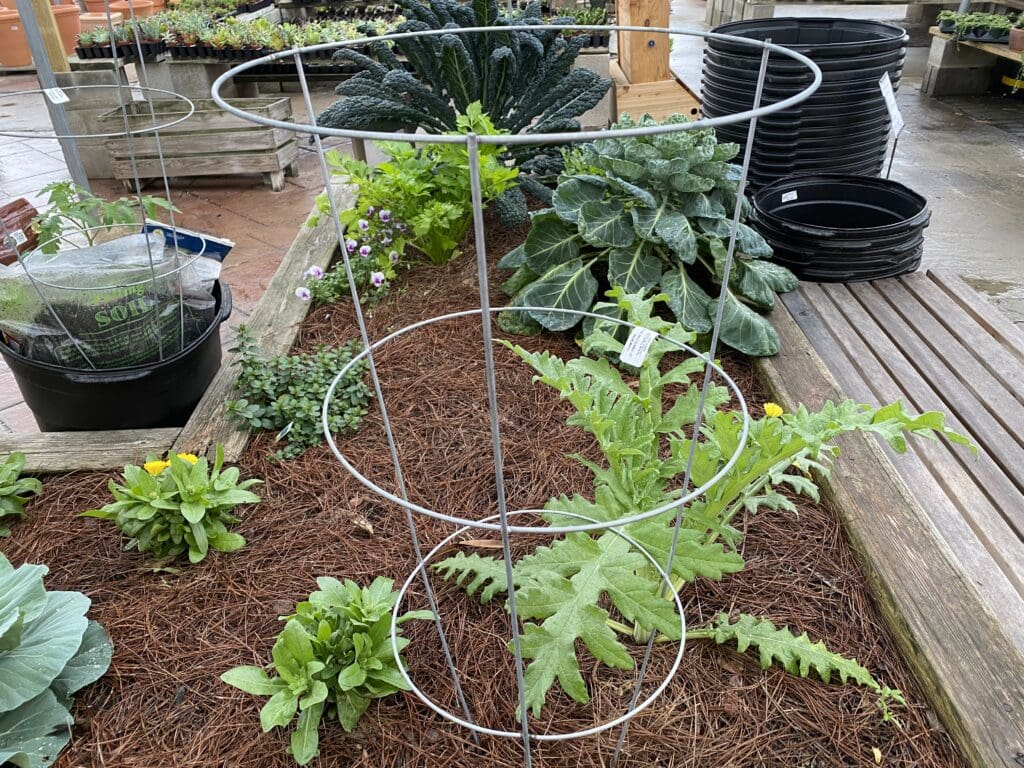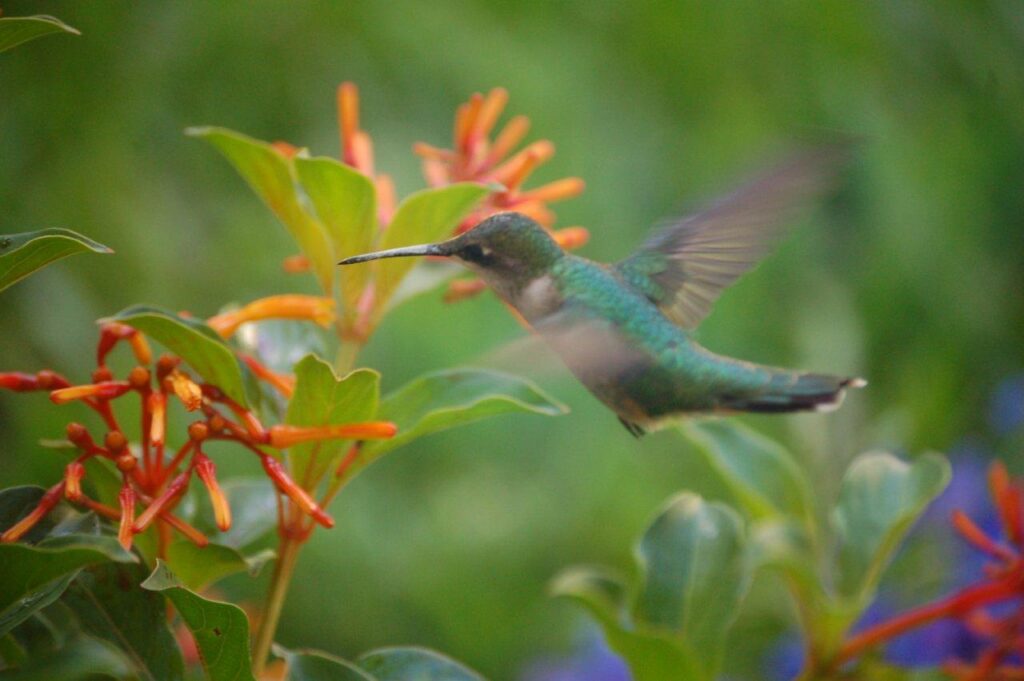We’ve had lots of lawn questions so far this spring, particularly about weeds. The short answer is…yes you can treat the lawn for weeds right now, but if you do, you need to wait to fertilize. This is one reason why we advise strongly against using any “weed and feed” combo products. Why would you want to fertilize the weeds you’re trying to get rid of?! Just remember: weed THEN feed. Click below to watch a quick PSA from DeAnna about how to take care of weeds first, then apply our favorite lawn food.
lawn
Now THIS is some gorgeous gardening weather!! We’re all busy planting, re-designing, fertilizing, and getting ready for holidays and weekends outside with family and friends. Here are our top tips for making the most of a very important month in the garden.
1. Feed Your Lawn and Plants
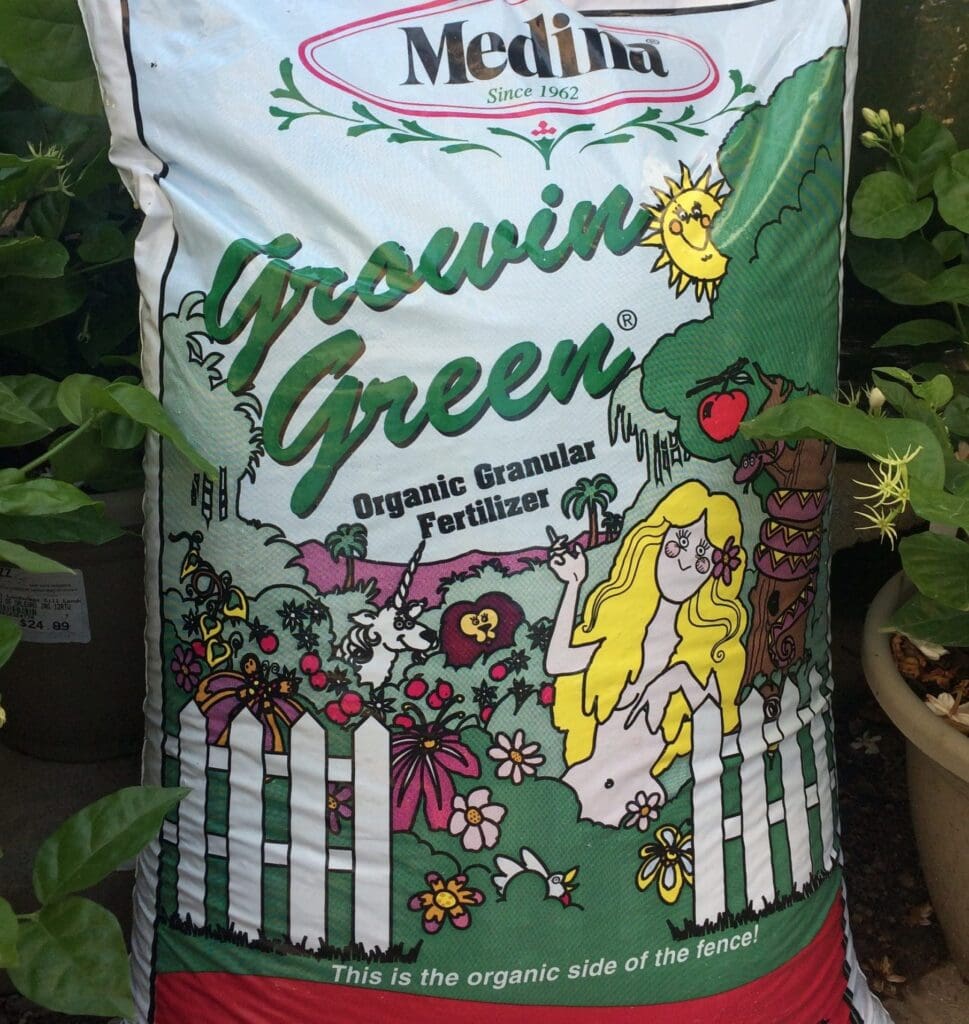
Fertilizing/feeding your plants this month is a must. This includes lawns, trees, and most plants. Everything is actively growing, which means they’ll need more food to continue looking their best. For lawns we love to apply organic Medina Growin Green once in Spring (now!), once in Summer, and once in the Fall. Medina Growin Green is a great multi-purpose food for shrubs and trees too. For blooming perennials, annual flowers, and veggies we really like organic Plant Tone by Espoma and Medina Hasta Gro liquid. Feed with Plant Tone on the 1st of each month, then follow up with liquid Hasta Gro on the 15th. Add these reminders to your calendar and you can’t go wrong!
2. Watering Wands Win!

Hand watering with a watering wand that has a cutoff valve is the most efficient and best way to water, especially for new plantings. Watering plants low to the ground keeps water from escaping via wind and evaporation and keeps water off the leaves which can invite fungal issues. Watering slowly (by turning down the pressure on your watering wand or kinking your hose) ensures that more water gets down to the roots instead of running off the surface.
As of right now, with Stage 2 watering restrictions in effect, you can use sprinklers or spray irrigation once every 2 weeks. Check your watering schedule here. Lawns and established landscapes will like this schedule if you water slowly, deeply, and consistently. For new landscape projects, and some other situations, you can apply for a temporary exemption to watering restrictions and use sprinklers and irrigation systems in order to help get plants, lawns, and trees established. We can help you file for the exemption if you like – it’s a straightforward process.
Keep in mind that hand watering and drip irrigation/soaker hoses are not limited by current watering restrictions. You can hand water or supplement with drip irrigation any time as needed. We carry the pro watering wands that we use here at Gill’s as well efficient sprinklers, moisture meters, timers, and soaker hoses.
3. Plant Blooming Perennials for Pollinators

April is time to add some blooming perennials to attract pollinators like butterflies, bees, and birds to your garden. You support pollinators (and the planet!) and in return they help you have more blooms, better production on your veggies, and a more vibrant landscape! Remember – April is when we start seeing hummingbirds! Add a few of their favorites like this native Salvia greggii, native Flame Acanthus, or firebush and make your backyard a preferred stop.
4. Plant Your Warm Weather Veggies

It’s time to plant hot peppers, squash, zucchini, basil, beans, and more! Tomato time has almost passed, but we still have a few if you still really want to plant a tomato – or better yet, a tomatillo! When starting veggies, the trick is to get the soil as active and alive as possible. Amend your existing soil with Nature’s Blend Compost (about 1 bag per 12 sq. ft.), then add a little Bio Tone starter fertilizer with mycorrhizal fungi and a good handful of worm castings when you plant each plant. Then follow our trusted fertilizer schedule – Plant Tone on the 1st of the month and liquid Hasta Gro on the 15th! Remember that veggies use a lot of energy and need these regular feedings to produce. Plus, strong, vigorous veggie plants are less susceptible to pest damage.
5. Get Ready for Guests
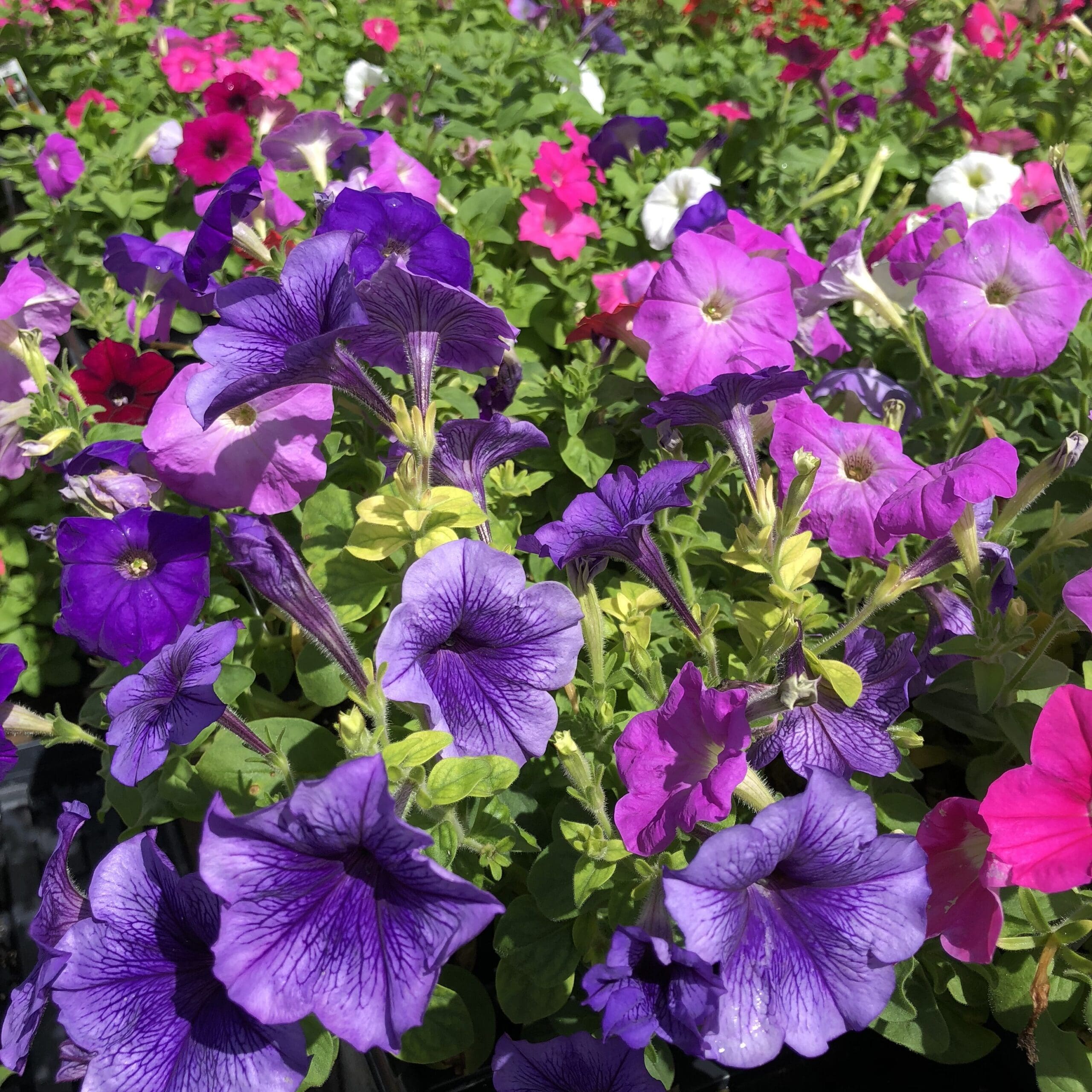
We’re wrapping up March and rolling into April with a gorgeous Easter weekend! For the quickest and easiest impact outdoors, think hanging baskets full of Impatiens, Vinca, Purslane, Geraniums and more overflowing with color. Some pops of color plus fresh mulch in your beds and you’re ready to host! We’ve extended our mulch sale through 4/4/24 to help with that! For indoors, our favorite flower arrangements are those cut fresh from the garden and landscape.
Check out our April Garden Guide for more tips!
Happy Earth Day Weekend! A big part of our purpose here at Gill’s is to help gardeners be the best stewards of their pieces of the earth that we all share. We want to help you create beautiful gardens that only get better with time, which means nourishing life in the soil and choosing the right plants. Here are a few areas of focus if you’d like to make your landscape more earth-friendly for Earth Day and beyond!
Focus on Nurturing Life in the Soil
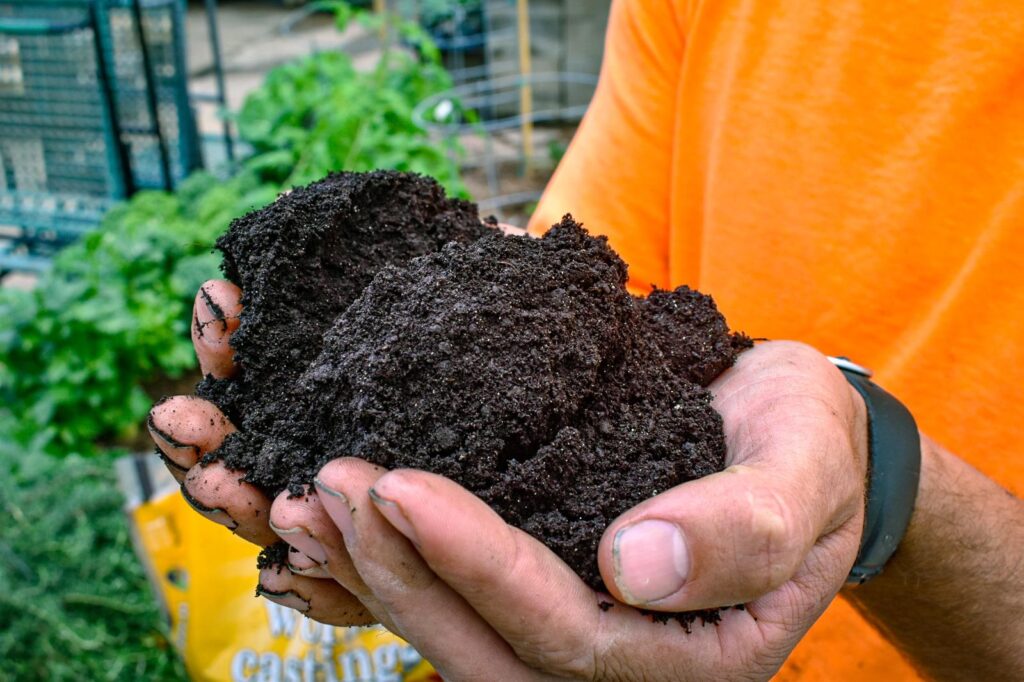
Gardeners know that it all starts with healthy soil. By healthy, we mean ALIVE with all the microbes and fungi that help plants grow stronger roots. We also know that the soil types in our area (heavy clay or sand) need some amendment. Adding compost, worm castings, using organic plant food, and using natural hardwood mulch all help keep those microorganisms active and thriving. Over time, your soil will become lush and beautiful and your established and new plants will thrive. It also makes digging and working in the garden so much easier and more fun! Keep these soil microorganisms in mind if/when it’s time to treat for pests. This is the main reason why we almost never recommend chemical pesticides – they kill the good stuff in the soil too. Many pest problems can be solved by treating organically or by doing nothing at all.
Choose Plants that Support Pollinators
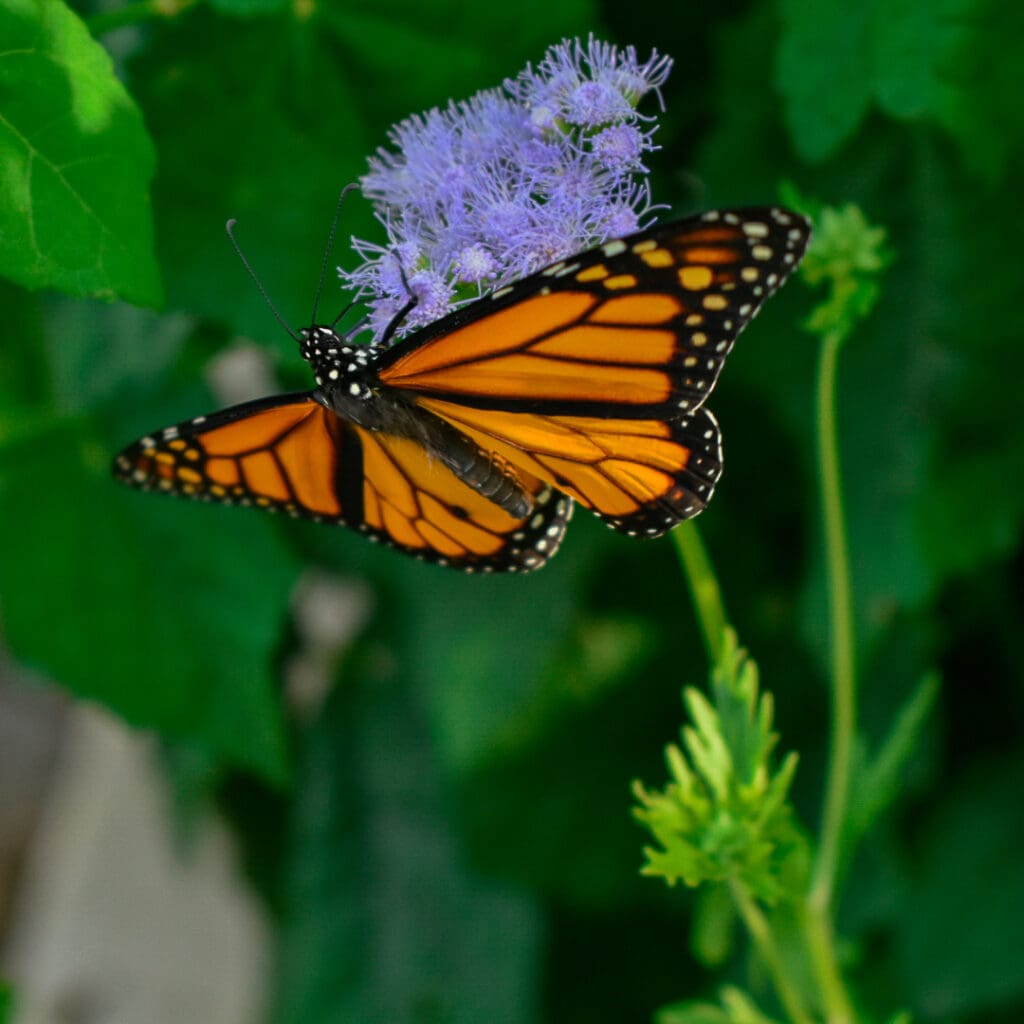
If we’re focused on supporting life in the soil, we can also focus on supporting important wildlife above ground with the plants we choose. We have so many options design-wise in South Texas for plants that attract and feed birds, butterflies, moths, bees, and other insect pollinators. Think of a well-placed native Yaupon Holly + a bird bath near a window where you and your pets can watch birds. Think of a fence line pollinator bed filled with different native and cultivated salvia varieties + Gregg’s Mistflower for butterflies. Think of a boring curb strip seeded with native wildflower mix. And right now, you can gear up for the April hummingbird migration by planting Firecracker Plant, Firebush, Turk’s Cap, Flame Acanthus, and many more. So many options for beautiful AND beneficial!
Reduce Lawn Space
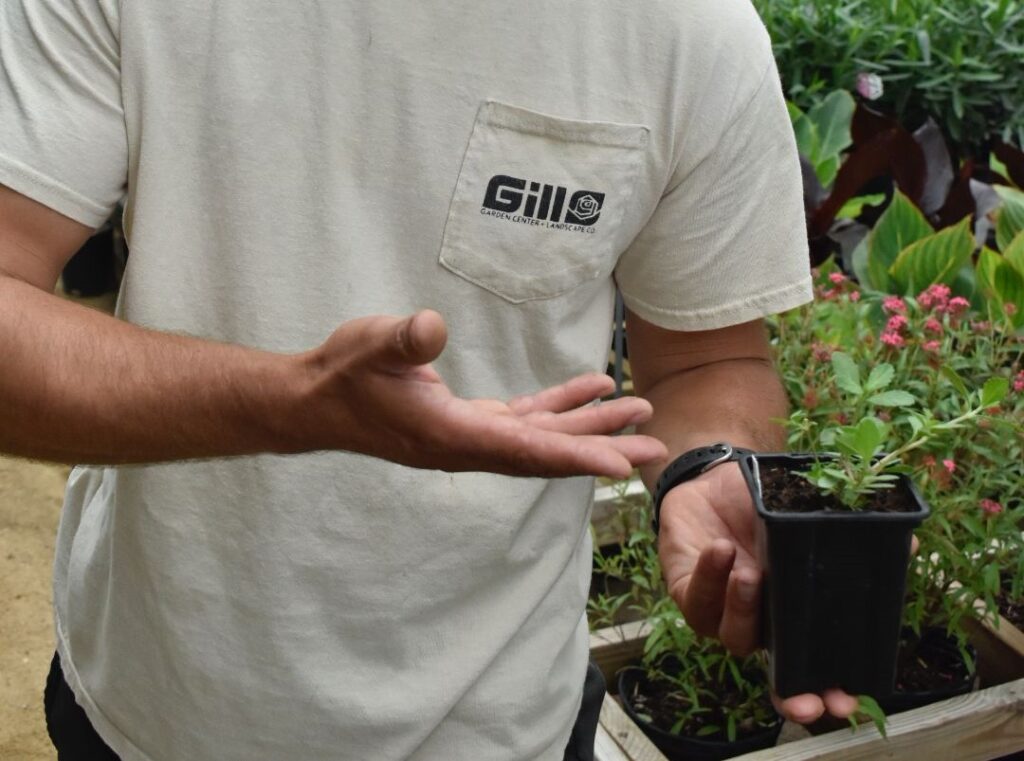
With so much interest in supporting pollinators, combined with our current watering restrictions and a more modern restorative approach to landscape design, many of us are reconsidering the traditional lawn. It’s estimated that there are over 40 million acres of turfgrass lawns in the US. That means 40 million acres of diverse native plants that once supported wildlife have been replaced with a monoculture that provides no benefit to the ecosystem. Does this mean we should immediately remove and replace our entire lawn with natives? Maybe, but we can have a big impact by just reducing some lawn space. Think of it this way – how much of your lawn do you actually use? Could some of that space be devoted to new beds filled with plants that serve more of a purpose and use far less water? Could some of that space be converted to native groundcover like Wooly Stemodia, Dichondra, Frog Fruit, or Horseherb that use far less water than grass and don’t require any mowing?!
Yay for May! Everything’s growing and blooming and we hope you are too! May is Mental Health Awareness Month, which is a good time to think about the peace of mind that gardening brings us. Gardeners know that all the research is true – gardening is good for you! Here are our Top 6 Must Do’s this May to keep you and your garden feelin’ good.
1. Join Us for Garden Talks and Events!
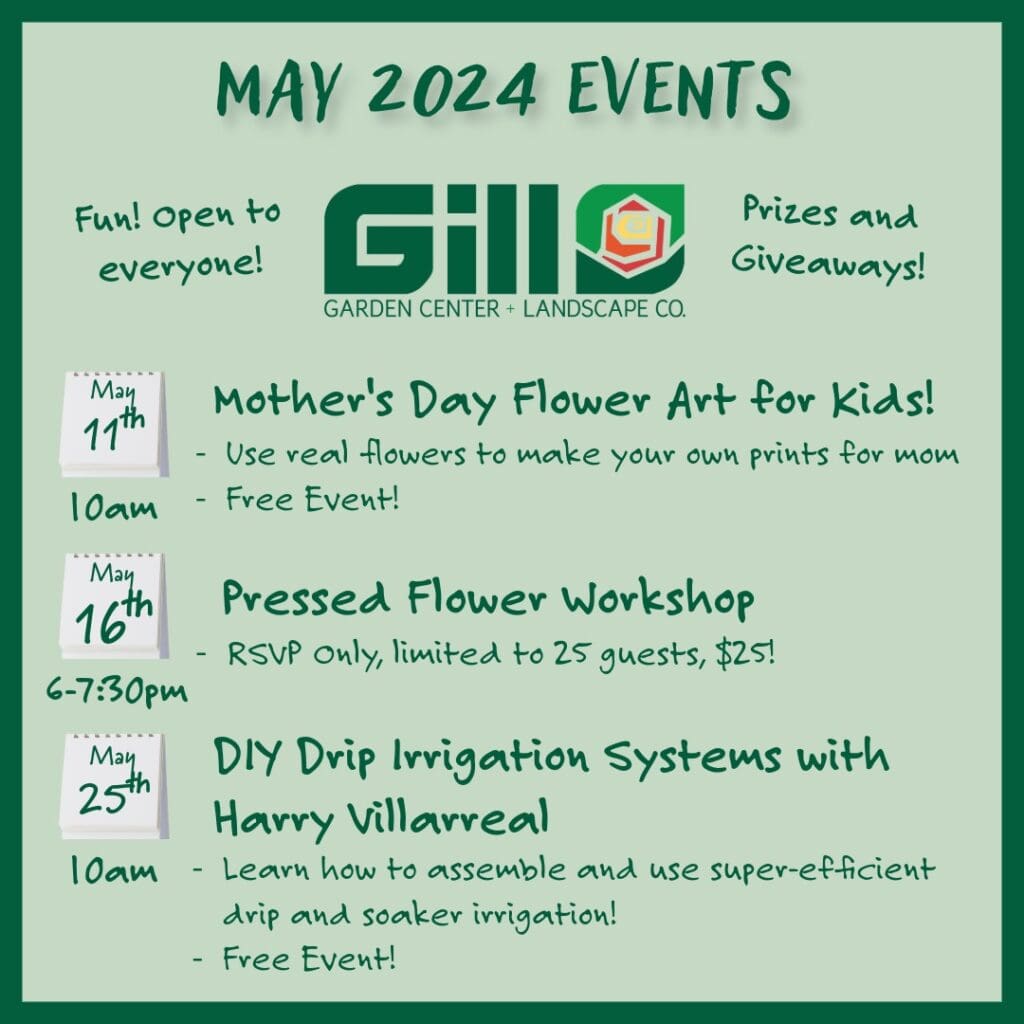
We’ve got a fun May planned here at Gill’s, and we’re kicking it off Saturday, May 11th with our Mother’s Day Flower Art for Kids workshop! Then we’re hosting an RSVP-only pressed flower workshop the evening of May 16th, and an informative talk on setting up your own drip irrigation system on May 25th. Sure to be lots of fun and lots to learn and discuss! Click here for more info!
2. Plant Blooming Perennials and Trees

It’s still time to plant lots of different blooming perennials and blooming trees. Get them established in May so they are better adapted to withstand warmer temps this Summer. Staples like Esperanza, many varieties of Salvia, Lantana, and tons more are all blooming beautifully right now. And blooming trees like Vitex, Retama, and Wild Olive are looking great right now too. Added bonus: these blooming perennials and trees attract lots of butterflies and hummingbirds!
3. Plant and Harvest Veggies

Warm weather veggie time! Plant peppers, zucchini, squash, and okra this month for continued harvesting into the Summer months. If you planted tomatoes, cucumbers, and other early Spring veggies, you’ll be harvesting now or very soon. Be sure to harvest often! It keeps birds & insects from finding them first. If you do have insect issues in your veggie garden, our go-to organic control is Spinosad – safe for food but takes care of bugs. Recent rain showers have been great for veggie gardens. Remember to keep watering as the weather warms up to maintain depth moisture. Soaker hoses are great to snake around your plants keeping water close to the ground and root systems.
4. Transition Your Lawn to Summer

Water deeply once every 2 weeks unless we get rain (per current watering rules). Watering once every 2 weeks with your irrigation system or sprinklers IS sufficient to keep lawns healthy through the summer. If necessary, you can supplement with hand watering. The key is to focus on depth moisture and root health – not necessarily a perfect green appearance all summer long.
When mowing, the proper height for St. Augustine lawns is around 3 inches. For Bermuda lawns, keep mowed to around 2-2.5 inches. Buzzing lawns shorter than that will cause lawn stress, and stressed lawns are more susceptible to pests, weeds, and disease.
Feed with Natural Fertilizers: Medina Growin Green or Milorganite. These feed the lawn and the soil with great results. Water in to get them started. Plus you can use them elsewhere in your landscape for plants and trees.
Watch for lawn insects & treat when needed. Grub worms & chinch bugs are easy to control when caught early but there’s no need to treat unless you have them. Bayer Season-long Grub Control will do the trick for grubs. Cyonara takes care of chinch bugs. Reminder, you can bring us a grass sample any time you suspect a lawn disease or pest. We’ll diagnose (using our microscope if needed) and get you what you need to knock it out.
Consider reducing your lawn space! Does all this lawn stuff sound like a lot of work? It can be! Many of us are reconsidering whether we really even want all that green lawn space. Why not start converting small portions of lawn to planting beds filled with blooming perennials that benefit the environment and use far less water? One way to start would simply be to deepen existing landscape beds to reduce some lawn.
5. Set Your Mosquito Traps!

We are big fans of the simple bucket mosquito trap. Just fill a bucket 3/4 with water, add a good handful of lawn or plant clippings, and toss in a Mosquito Dunk or Mosquito Bits. These dissolve in the water and release bacteria that target mosquito larvae and kill them before they hatch. And they’re organic and not harmful to birds, bees, pets or humans! Set a few of these traps, sprinkle some organic Mosquito Beater granules around walkways and patios, spray organic Cedar Repel on your lawn, and use Skeeter Screen incense sticks near where you’re working or hanging out outside. Remember that using chemical mosquito foggers kills all the good bugs too, some of which also help control mosquitos and other bad bugs.
6. Gifts for Moms and Grads

Let us help you find something pretty, useful, or both for the gardening moms and grads in your life. Pottery, birdbaths, wind chimes, garden tools, hats, gloves, garden decor, gift cards – lots of options. Check out the Bee Puddles handmade by ceramicist and Gill’s own Wyatt Page! Help bees stop for a drink. Or find the gift that gardeners love most – plants 🙂
Visit our May Garden Guide for more tips! Happy gardening!
Here’s to summer garden fun! We’re making the transition to warmer weather with some intermittent rainfall and lots of good energy in the garden. Here are our top priorities this month, including what to plant, how to adjust watering, what to watch out for, and how to keep plant roots insulated and happy.
Check out our June Garden Guide for more tips and remember that trees, shrubs, and perennials can be planted 12 months out of the year! The only difference is the amount of water they need depending on temperatures and wind!
1. Plant Summer-Tough Stuff!
So many of our favorite plants for South Texas don’t just tolerate warm weather, they only begin to thrive and look their best in the summer. Think of blooming perennials like Firebush, Esperanza, and Pride of Barbados for awesome summer impact. Think of big purslane hanging baskets, Gomphrena, and Periwinkles for bursts of bright color. And browse our Texas native plant section for plants and trees that have thrived through hundreds and even thousands of Texas summers. If you’re still wanting to plant food, you can do that too – okra, basil, thyme, watermelon, peppers, black-eyed peas and more can be planted in June.
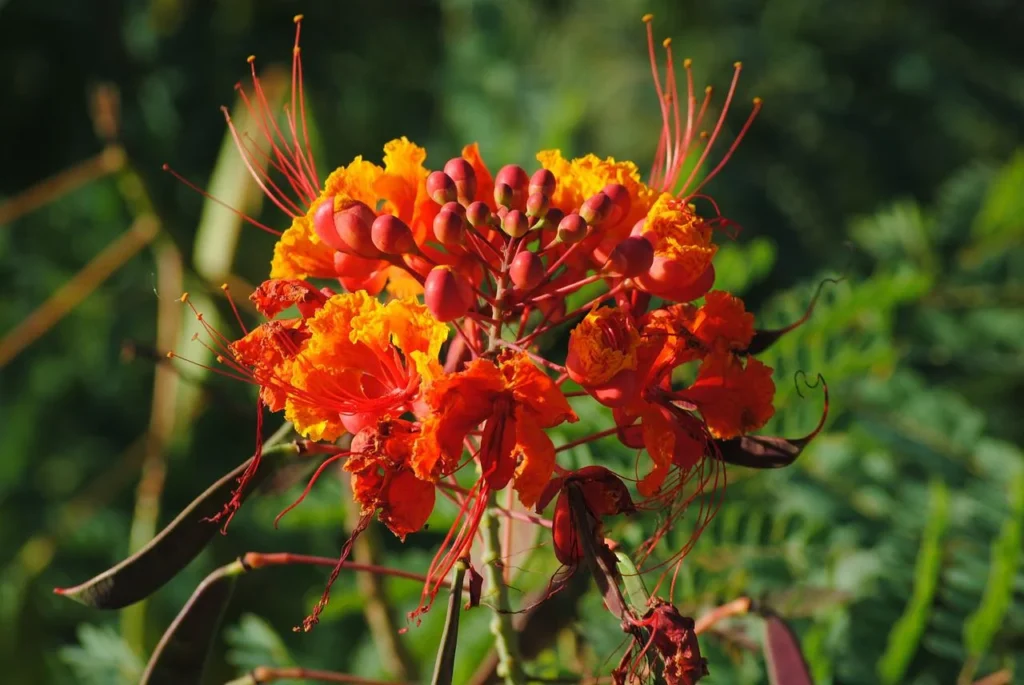
2. Water Low & Slow
We’re not talking about BBQ, although that sounds good too… We’re talking about watering low, as in as in low to the ground to avoid evaporation, and slow as in not with your hose open full-blast to decrease runoff and get more water down to the roots. Consider setting up your own automatic drip irrigation system – they’re easy to DIY and they operate on the low & slow principle. For spray irrigation sprinkler systems, be sure to follow current watering rules.
Pro tip: Use a moisture meter in your landscape beds and pots! We carry them for around $10 and can show you how easy they are to use. They’ve saved many plants!
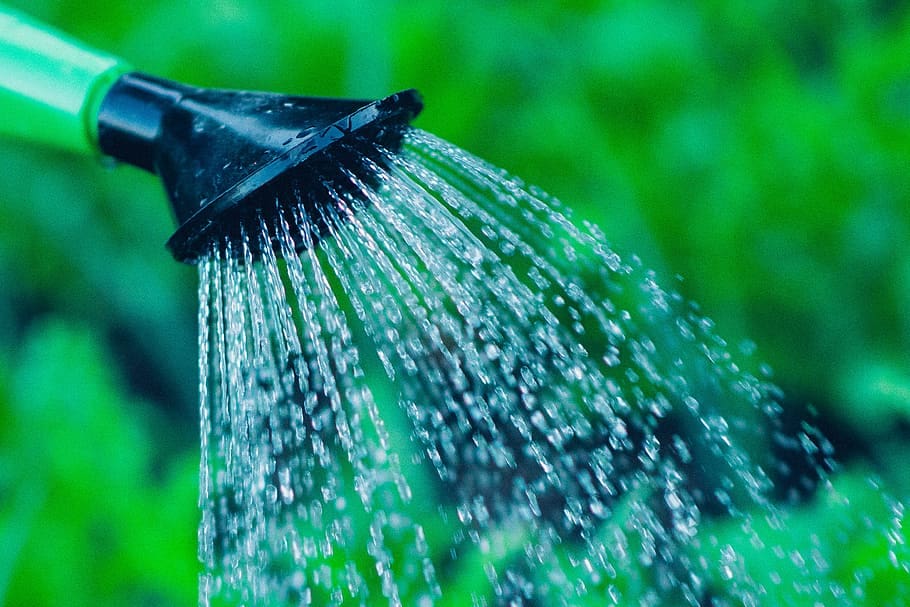
3. Watch for Summer Bugs and Disease
Yes, bad bugs will be around more during the Summer, but don’t treat unless there’s significant damage. We can help identify the pest and if/how to treat. You don’t want to kill too many good bugs while trying to take care of the bad bugs! If you see brown areas in the lawn that are easily pulled up, it’s usually a sign of grubs eating the roots of your grass. You can control grubs with Bonide Insect and Grub Control. Chinch bugs love hot dry areas in lawns. They make the lawn look dried out along sidewalks and pavement. Spot-treat those areas with Cyonara in easy ready-to-spray bottles. For organic control, use Spinosad or Diatomaceous Earth. Remember that healthy lawns are less susceptible to damage from bugs, heat stress, and common lawn disease like Take All Root Rot. Water lawns deeply and fertilize every 3 months. If you fertilized in April, wait to feed again in July.
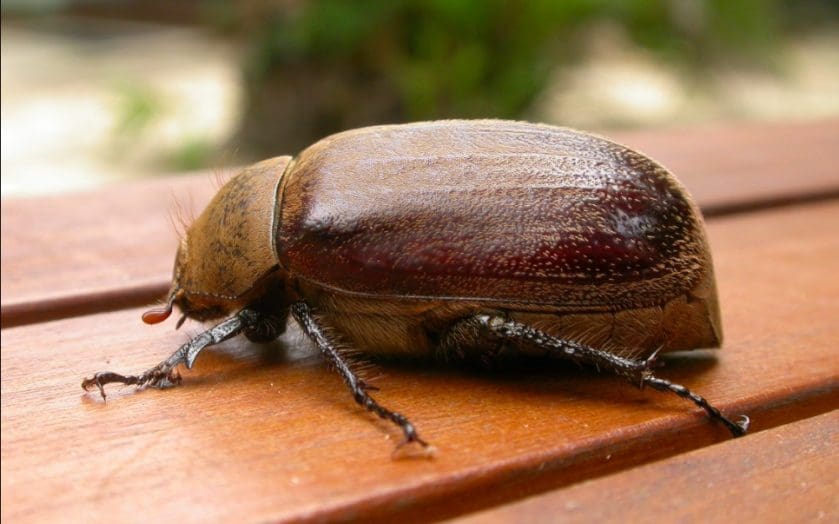
4. Hang Out with Your Houseplants
We just restocked the greenhouse with all kinds of unique and classic houseplants looking for their forever homes! Time to work on your collection! We can help you determine the best houseplants for different areas and different lighting in your home. Once again – invest in a moisture meter for your houseplants, too. In our experience, the main cause of houseplant death is too much love aka too much water. Keep in mind that houseplants can also be sensitive to tap water. We use as much A/C condensate, rainwater, and water from our dehumidifier as we can to water houseplants and keep them looking their best here at Gill’s.
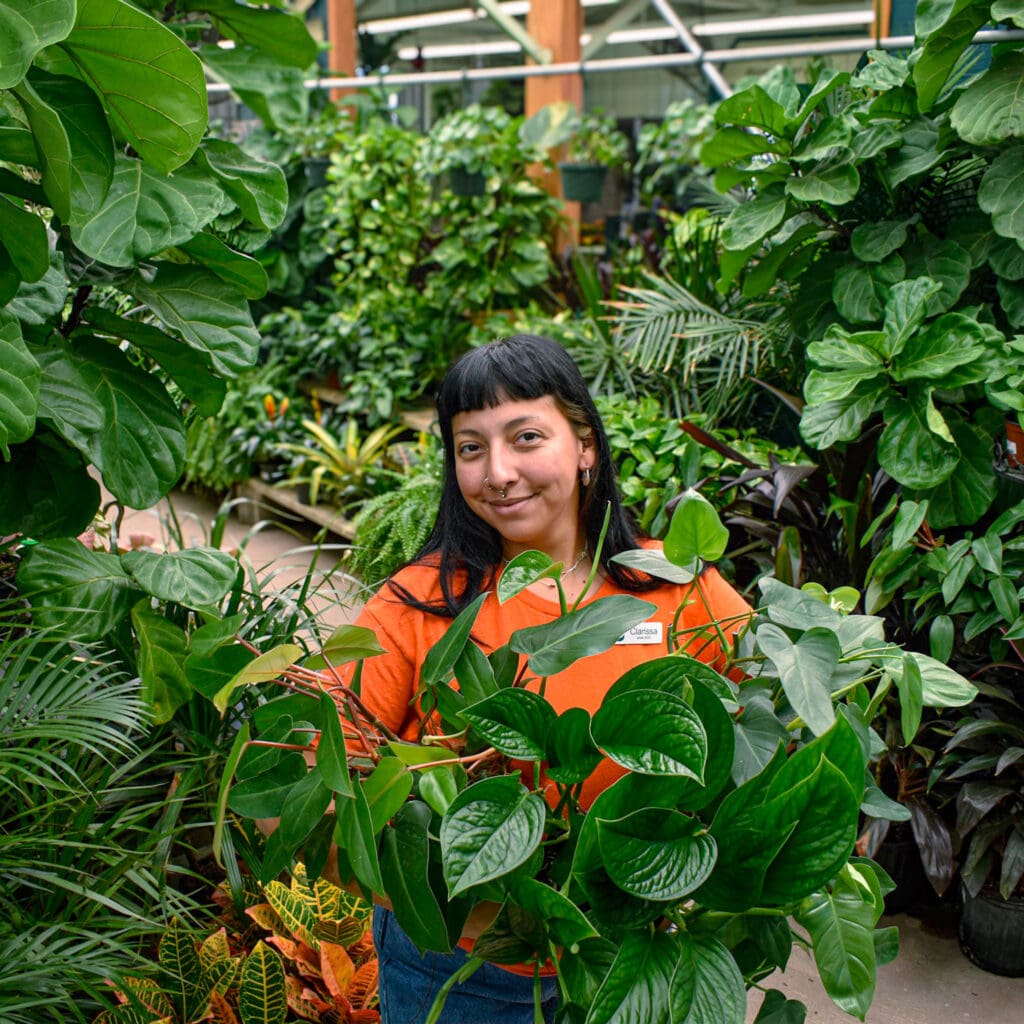
5. Keep Roots Cool with Mulch
A good mulch layer (2-3″ deep) has so many benefits. It looks amazing, keeps weeds down, helps retain moisture, adds organic matter to the soil, AND keeps plant roots nice and cool in the summer. Bartlett Tree Research Laboratories shared amazing results with us from a mulch study they conducted in San Antonio. Soil temperatures were measured at 6″ deep (where plant roots live) on a 105 F summer day. Bare soil, 6″ down was 102 F. Soil under grass was 92 F. Soil beneath a 3″ layer of mulch was only 76 F!! Mulch for the win!

Temperatures may not feel like it yet, but it’s time to start making the transition into an exciting new Fall planting season! There’s a lot to do in August to set yourself up for big garden success this Fall and beyond. Here are our top must-do’s!
Check out our August Garden Guide for more tips and remember that trees, shrubs, and perennials can be planted 12 months out of the year! The only difference is the amount of water they need depending on temperatures and wind!
1. Water to Maintain Depth Moisture!
Yay for rain!! It looks like there might even be some more in the forecast late next week! Since we have the luxury of good depth moisture, our goal with watering this month should be to maintain it. For lawns and established plants and trees, this means watering less frequently, but watering deeply when you water. New plantings will require water every day for the first couple weeks to get the roots established, but again, think deep drinks so the roots dive deeper. Use a water wand with a cut-off valve to make it easy on you and conserve water. Pro tip: Conserve water by watering at ground level, not spraying from above. This way, water soaks down to the roots rather than evaporating off the leaves.
2. Start Planting for Fall Pollinators!
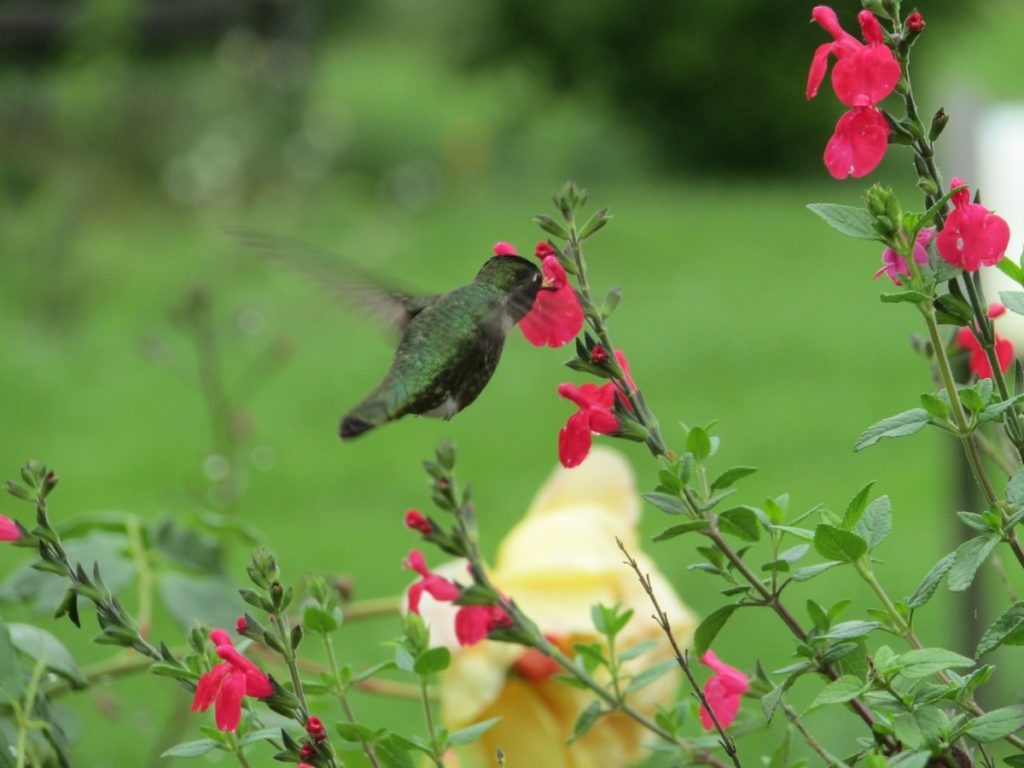
Important fact: birds, bats, bees, butterflies, beetles, and small mammals that pollinate plants are responsible for bringing us one out of every three bites of food. Plants attract and provide food for them to keep the cycle going. For example – plant Zinnia and sunflower seeds now, and they’ll be ready to feed migrating birds this Fall. Plant salvias now, get roots established, and they’ll be gorgeous this Fall and covered in hummingbirds, butterflies, and bees. Take it a step further and plant Texas natives! They provide for pollinators and require less water once established. If you’re excited about planting natives for pollinators, check out Homegrown National Park! It’s a nationwide movement to plant natives and restore native biodiversity at home. Just by planting a few native plants, you can get your yard on the map and become part of the Homegrown National Park.
3. Pick Out Your Seeds!
Watching your plants grow from a tiny seed is exciting and rewarding! Our Fall Vegetable Planting Guide provides the specific seed-planting dates to help plan your Fall garden. In early August, we’ll receive the new 2024-2025 seeds from our favorite seed suppliers, including heirloom vegetables, new releases, and wildflower seeds. Use peat pots or seed starting trays to start seeds indoors this month, then move to a covered patio once they sprout. This will protect the seedlings and slowly acclimate them to outdoor temps.
4. Prep Your Garden Beds
August is the time to start prepping Fall veggie beds! Finish your Summer harvesting, clean out your beds, and pull weeds. To get your soil ready, we recommend mixing Nature’s Blend Compost or Cotton Burr Compost into your soil to replenish nutrients and loosen the soil before planting. About 1 bag per 12 sq. ft. is good. Once prepped, add a thick layer of pine straw mulch, which will help retain moisture, keep weeds from sprouting, and keep the soil cooler until you’re ready to plant. As you plan your space, think crop rotation – don’t plant the same veggies in the exact same place you planted them last season, or you encourage pests and diseases.
5. Mulch for Moisture Retention
We know fresh mulch is the quickest way to refresh the look of your landscape. Proper mulching has other big benefits, especially during hot weather. A good 3” deep layer of mulch will keep your plants and the soil moist and cool for longer after you water or after it rains. Not just a little cooler – we’re talking more than 25 degrees cooler!! Give the main trunks or stems of your plants a little space – mulch 3” deep throughout the bed, but no more than 1” deep against the main trunks/stems of plants.
6. What About All the Weeds??
With all this amazing rain comes lots of weeds! We can’t apply weed killer to lawns right now because temperatures are still too high – we need to stay below 90 degrees to be able to treat existing lawn weeds. For now, keep the lawn mowed to prevent weeds from going to seed, and apply pre-emergent Weed Stopper with Dimension to prevent new weeds from sprouting. For landscape beds, we recommend spot treating weeds with an organic contact killer like Horticultural Vinegar or Captain Jack’s Deadweed Brew. For pesky Bermuda grass in beds, spot treat with Grass-B-Gon, and for our old friend nutsedge (aka nut grass), use Sedgehammer. Keep in mind, Bermuda grass and nutsedge will likely require several applications to eradicate.
It sure feels like summer outside, but in order for fall tomatoes and peppers to have time to produce lots of fruit, we gotta plant em now! Here are a few tips for growing the most and the tastiest tomatoes and peppers.
1. Count Your Days to Maturity
The average tomato, like our beloved Celebrity slicing tomato, needs about 70-80 days to mature and produce fruit. That means they’ll be ready around the beginning of November if we plant today. Similarly, Jalepenos and bell peppers need 60-80 days to maturity. Be sure to get them planted now or very soon so you can get a good harvest before we have chances of cold weather which tomatoes and peppers can’t handle.
2. Adequate Spacing + Cages for Support
When planting, keep in mind that tomatoes should be planted a good 4 feet apart, and peppers should be 2.5-3 feet apart. This gives them room to grow to their full potential, ensures good airflow around the plants, and helps prevent pest outbreaks. Remember – tomato cages are your friends! It’s important to cage the tomato right when you plant so you don’t risk breaking branches if you try to add a cage later. A tomato cage works great for supporting pepper plants too. And be sure to have some flexible green garden tie tape to help secure floppy branches, especially when they get heavy with fruit! The flexible tape is nice because it’s soft and won’t cut into the plant like string or wire would. Yes, we have some!
3. Follow DeAnna’s Tried & True Feeding Schedule
Remember that plants use lots of energy to produce fruit, so they need plenty of good food! Use compost and Biotone Starter Plus you plant to promote good soil microbes and bigger roots. Then take DeAnna’s advice on feeding: apply a quality granular fertilizer (Plant Tone or Medina Growin Green) on the 1st of the month, then supplement with liquid Hasta Gro on the 15th. Add these reminders to your calendar to make it easy. Follow this schedule and you’ll have tomatoes & peppers to share!
It’s almost that magical time of year again when ruby-throated hummingbirds make their way through the Coastal Bend on their way south for the winter! Expect to start seeing hummingbirds around town any day now, with peak numbers around mid-late September, right in time for the Rockport-Fulton Hummerbird Celebration. With our hungry guests arriving very soon, it’s time to set the table with all the right hummingbird plants! Here’s what and how to plant to make your yard a preferred stop on the migration path.
1. Plant Tubular Blooms in Shades of Orange and Red
If we think about our list of top-notch hummingbird-attracting plants like Firebush (pictured), Flame Acanthus, Firecracker (russelia), Salvia greggii, and Coral Honeysuckle, to name a few, they all have tubular blooms that are perfect for a hummingbird’s long, skinny beak. And their blooms are all shades of orange and red! Hummingbirds have a high concentration of cones in their retinas which filter color differently than what we see. To hummingbirds, the red spectrum appears more vividly while blues appear more muted. That said, scientists have run experiments with different color blooms and found that hummingbirds learn very fast which blooms have the most nectar, regardless of bloom color. As a local example, we know that hummingbirds also love Duranta‘s blooms which are purple and not tube-shaped. Lantanas are another plant that hummingbirds seem to love in all colors.
2. Plant in Groups, Not Just 1 or 2
When planting for hummingbirds and other pollinators, make your food sources easy to find. Instead of planting 1’s and 2’s of hummingbird plants spread out across the yard, plant a few or several of the same plant in a group. This helps mimic how most plants are found in nature, helps the hummingbirds spot them more easily, and provides a higher concentration of nectar. If you have limited space, go with 3 of the same plant rather than 1 of each. We had a customer call Gill’s this week to ask about hummingbird plants for her balcony…on the 13th floor! That may seem like a stretch, but hummingbirds can fly up to 500 feet – if they have a good reason to fly up to your balcony, they can and will!
3. Supplement with High Quality Organic Food and Shallow Water
The right plants will get you more hummingbirds, but it doesn’t hurt to supplement with some feeders too. They need all the energy they can get for their long journey. Place your feeders in easy to access spots since they need to be cleaned regularly. And don’t use the fake red dyed “nectar” that you might find at big box stores. Use a high-quality, nutritious food that’s truly made for hummingbirds. We’re big fans of organic Hummingbird Momma, which is the only nectar we carry. And don’t forget about water! No hummingbird haven is complete without a shallow bird bath or fountain. They can’t stand in deeper water, so look for something very shallow!
